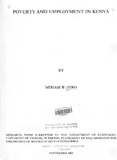| dc.description.abstract | Poverty refers to lack if basic necessities if life, including opportunities for development. At the time if independence in 1963, the Government if Kenya identified illiteracy, disease, ignorance and poverty as the main problems to be addressed in post independence era in order to achieve sustainable national development despite antipoverty measures of the past over 50 percent of the Kenyan population live in poverty On the average 71 percent of household income is spent on food: This shows that previous poverty reduction policies have not been effective. A gap still exists between policy maker's development intentions and the needs if the target group, the poor
The labour market is crucial for growth, income distribution and poverty alleviation. Its operation determines employment and wage outcomes. To be able to increase efficiency in the allocation of labour and therefore achieve higher growth, and in order to bringg about a better distnbution if income and thus reduce poverty, we need to understand the nature and pattern if employment in the labour market (both formal and informal).
This paper analyses poverty amongst the employed. We identified the poor using CBN and FEI poverty lines and analyzed poverty determinants using multivariate regression methods. The Welfare Monitoring Sumey Il (WMS Il) data was used in this analysis. The Central Bureau if Statistics collected this data in 1994; it consisted if approximately 11,000 households and 59,200 individuals.
The paper concludes with a discussion of policy implication of its main findings. The main findings are: that female headed households have a higher welfare than male- headed households; education is a significant determinant if poverty status as well as welfare; urban residents have a higher welfare than rural residents and lastly, the agricultural sector has the highest the poverty incidence. | en |

